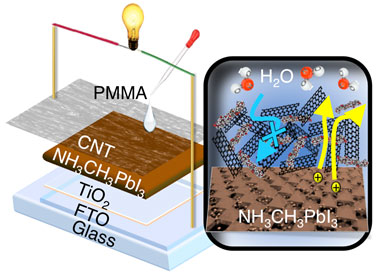Crossref Citations
This article has been cited by the following publications. This list is generated based on data provided by
Crossref.
Delacou, Clément
Jeon, Il
Otsuka, Keigo
Inoue, Taiki
Anisimov, Anton
Fujii, Takenori
Kauppinen, Esko I.
Maruyama, Shigeo
and
Matsuo, Yutaka
2019.
Investigation of charge interaction between fullerene derivatives and single‐walled carbon nanotubes.
InfoMat,
Vol. 1,
Issue. 4,
p.
559.
Jeon, Il
Yoon, Jungjin
Kim, Unsoo
Lee, Changsoo
Xiang, Rong
Shawky, Ahmed
Xi, Jun
Byeon, Junseop
Lee, Hyuck Mo
Choi, Mansoo
Maruyama, Shigeo
and
Matsuo, Yutaka
2019.
High‐Performance Solution‐Processed Double‐Walled Carbon Nanotube Transparent Electrode for Perovskite Solar Cells.
Advanced Energy Materials,
Vol. 9,
Issue. 27,
Zhang, Huiyin
Song, Keke
Zhu, Lianqing
and
Meng, Qingbo
2020.
Back-interface regulation for carbon-based perovskite solar cells.
Carbon,
Vol. 168,
Issue. ,
p.
372.
Jeon, Il
Shawky, Ahmed
Seo, Seungju
Qian, Yang
Anisimov, Anton
Kauppinen, Esko I.
Matsuo, Yutaka
and
Maruyama, Shigeo
2020.
Carbon nanotubes to outperform metal electrodes in perovskite solar cells via dopant engineering and hole-selectivity enhancement.
Journal of Materials Chemistry A,
Vol. 8,
Issue. 22,
p.
11141.
Qian, Yang
Jeon, Il
Ho, Ya‐Lun
Lee, Changhyun
Jeong, Sujeong
Delacou, Clement
Seo, Seungju
Anisimov, Anton
Kaupinnen, Esko I.
Matsuo, Yutaka
Kang, Yoonmook
Lee, Hae‐Seok
Kim, Donghwan
Delaunay, Jean‐Jacques
and
Maruyama, Shigeo
2020.
Multifunctional Effect of p‐Doping, Antireflection, and Encapsulation by Polymeric Acid for High Efficiency and Stable Carbon Nanotube‐Based Silicon Solar Cells.
Advanced Energy Materials,
Vol. 10,
Issue. 1,
Guo, Min
Wei, Chenyang
Liu, Congcong
Zhang, Kun
Su, Haijun
Xie, Keyu
Zhai, Peng
Zhang, Jun
and
Liu, Lin
2021.
Composite electrode based on single-atom Ni doped graphene for planar carbon-based perovskite solar cells.
Materials & Design,
Vol. 209,
Issue. ,
p.
109972.
Passatorntaschakorn, Woraprom
Bhoomanee, Chawalit
Ruankham, Pipat
Gardchareon, Atcharawon
Songsiriritthigul, Prayoon
and
Wongratanaphisan, Duangmanee
2021.
Room-temperature carbon electrodes with ethanol solvent interlacing process for efficient and stable planar hybrid perovskite solar cells.
Energy Reports,
Vol. 7,
Issue. ,
p.
2493.
Jaffri, Shaan Bibi
Ahmad, Khuram Shahzad
Thebo, Khalid Hussain
and
Rehman, Faisal
2021.
Recent developments in carbon nanotubes-based perovskite solar cells with boosted efficiency and stability.
Zeitschrift für Physikalische Chemie,
Vol. 235,
Issue. 12,
p.
1539.
Mujahid, Muhammad
Chen, Chen
Zhang, Jian
Li, Chuannan
and
Duan, Yu
2021.
Recent advances in semitransparent perovskite solar cells.
InfoMat,
Vol. 3,
Issue. 1,
p.
101.
Lin, Hao-Sheng
Hatomoto, Riku
Miyata, Daisuke
Huda, Miftakhul
Jeon, Il
Hashimoto, Satoru
Hashimoto, Takeshi
and
Matsuo, Yutaka
2022.
Scalable eDIPS-based single-walled carbon nanotube films for conductive transparent electrodes in organic solar cells.
Applied Physics Express,
Vol. 15,
Issue. 4,
p.
046505.
Zhao, Yajie
Ge, Rui
Zheng, Jieyuan
Chen, Lirong
Wang, Xingru
Zheng, Yang
Zhong, Liuwen
Zhu, Yanqing
Xu, Xueqing
Xu, Gang
and
Xiao, Xiudi
2023.
CsPbIBr2‐Based Bifacial Semitransparent Solar Cells for All‐Day Applications.
Energy Technology,
Vol. 11,
Issue. 11,
Srivishnu, Kalavala Shivaprakash
Markapudi, Prasutha Rani
Sundaram, Senthilarasu
and
Giribabu, Lingamallu
2023.
Semitransparent Perovskite Solar Cells for Building Integrated Photovoltaics: Recent Advances.
Energies,
Vol. 16,
Issue. 2,
p.
889.
Kreta, Ahmed
Swillam, Mohamed A.
Guirguis, Albert
and
Hassanien, Abdou
2023.
Unbundling SWCNT Mechanically via Nanomanipulation Using AFM.
p.
83.
Meng, Fanning
Wang, Dongsheng
Chang, Jiarun
Li, Jihui
and
Wang, Guiqiang
2024.
Application of Carbon Materials in Conductive Electrodes for Perovskite Solar Cells.
Solar RRL,
Vol. 8,
Issue. 6,






